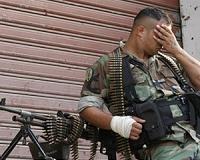| . |  |
. |
Washington DC (SPX) Aug 04, 2010 From the many images sent home from foreign battlefields over the last several decades, Americans have viewed the plight of their country's combat-weary veterans as stark and often iconic scenes that seem somehow frozen in time. But recent research at Washington State University (WSU) suggests that, for many U.S. veterans, combat is a defining experience that often sets the trajectory of the balance of their lives. In research published in the August 2010 issue of the American Sociological Review (ASR), Alair MacLean, an assistant professor with the Department of Sociology at WSU Vancouver, reports that in comparison to both non-veterans and veterans who never engaged in combat, Americans returning from combat face significant socioeconomic challenges, as evidenced by consistently higher rates of disability and unemployment. "Veterans who saw combat started their work lives at a relative disadvantage that they were unable to overcome," MacLean said. "Soldiers exposed to combat were more likely than non-combat veterans to be disabled and unemployed in their mid-20s and to remain so throughout their worklife." Using data taken from the Panel Study of Income Dynamics, a longitudinal survey of families and individuals which has been conducted annually since 1968, MacLean studied the characteristics of both veterans and non-veterans who would have been between the ages of 25 and 55 in any year between 1968 and 2003. The sample included men who served or otherwise would have become eligible for military service during World War II, as well as during the Korean, post-Korean, Viet Nam, and post-Viet Nam eras. MacLean said the rate at which both non-veterans and non-combat veterans reported themselves to be disabled remained fairly consistent at roughly 10 percent of the population in each of the years reviewed by the study. "Compared with these two groups of men, combat veterans were disabled at relatively high rates," she said. "In most survey years, they were more likely than non-veterans to be disabled. In all survey years, they were more likely than non-combat veterans to be disabled." Additionally, MacLean found that combat veterans were more likely than the other groups to become disabled over time. "In 1968, slightly over 10 percent (of combat veterans) were disabled. This increased to over 20 percent in 2003," she said. And while combat veterans tended to be employed in the initial years of the surveyed period at higher rates than the other two groups, MacLean said they reported significantly higher levels of unemployment than either non-veterans or non-combat veterans in most years after 1975. "What the data suggests is that combat may scar veterans who experience it, leading them to be less able to find work between the ages of 25 and 55, the prime working years," she said.
Share This Article With Planet Earth
Related Links American Sociological Association
 Israeli officer killed, one critical during Lebanon clashes
Israeli officer killed, one critical during Lebanon clashesMisgav Am, Israel (AFP) Aug 3, 2010 A senior Israeli officer was killed and another critically wounded on Tuesday during clashes with the Lebanese army along the flashpoint northern border, the Israeli military said. "An IDF officer was killed today by Lebanese Armed Forces fire on the Israel-Lebanon border," a statement said, naming the dead man as Lieutenant Colonel Dov Harari, 45. Harari served as a battalion commander. ... read more |
|
| The content herein, unless otherwise known to be public domain, are Copyright 1995-2010 - SpaceDaily. AFP and UPI Wire Stories are copyright Agence France-Presse and United Press International. ESA Portal Reports are copyright European Space Agency. All NASA sourced material is public domain. Additional copyrights may apply in whole or part to other bona fide parties. Advertising does not imply endorsement,agreement or approval of any opinions, statements or information provided by SpaceDaily on any Web page published or hosted by SpaceDaily. Privacy Statement |